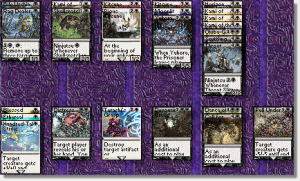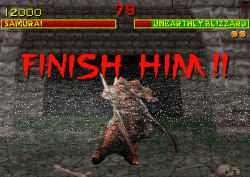Here we go again, it’s PTQ season for those of us in the North East. Time to wrap up those Extended decks and throw them on eBay, and get those good luck charms going because it’s Sealed Deck season again!
Say it with me now, “Siiigh.”
Here’s the problem with Sealed Deck: you get an unopened pack of cards and have to build a deck out of it. How many rares in there? Three. How many boosters? Two. So that’s a grand total of five rares, which means you get five chances to open a Kumano, Meloku, Jitte or random (non-Red) Dragon. Oh you didn’t open up one of those? Oh darn, unless you’re really good at Magic the chances of you Top 8’ing this PTQ just went down dramatically. Now if you’re an unlucky sap like me, you’d better grab a cup of coffee and read the rest of this article, because you’ll probably be opening a lot of Misako’s and Swirl the Mists this season.
Each person has their own preferred method for looking over their Sealed Pools. I’ll outline mine because I use it, and I think it works pretty well. I begin by opening up my Sealed Deck, and then I take out the reg sheet and throw it to the side. After that I take a look and see if the cards are color coded and alphabetized. If they’re not, I start mumbling curses and get the reg sheet out cause I figure if the guy is dumb enough to screw up organizing the cards, then he probably screwed up on the reg sheet, and heck, why not get him a warning for annoying me.
After you’re comfortable with what cards you have, color code them if they aren’t already, and go through each color for the unplayables. I have a much looser definition of unplayable than most people, but even so you should be able to get rid of a bunch of cards at this point. Cards like Swirl the Mist, Reito Lantern – I mean just anything completely unplayable – just get it out of there. This way you’ll have the smallest number of cards to analyze and you still have some cards bouncing around in your head if you need some sideboard cards in your main deck (here’s looking at you Terashi’s Grasp).

I like to look at two colors first when laying out my colors: White and Black. Not only are White and Black the best colors in this block, they have the best commons and you can assume one of them is going to be deep enough to be a main color. As always, I separate spells from creatures and lay them out in a curve. At this point you will have a deck in front of you like on Magic Online laid out in curve order filled with White and Black cards. Staring at this mess you should be able to see a few things immediately. Do you have any Black removal? Is your creature curve any good? Do you have any bombs in these colors that make it important to play that color? By the by, rares are not necessarily bombs. Konda, Lord of Eiganjo is not a bomb even though he’s a rare, so don’t feel that it’s necessary to play White because you “mised” him or his boy-toy Takeno.
All right, so you checked out Black and White, maybe they’re something special, maybe not. Now you get to look at the other three colors, Red, Blue and Green. You can do these colors before Black and White or after, it’s up to you really. These three colors are similar because in this block, at least two, or maybe even all three, of these colors will be way too shallow to consider for anything more than a splash card. Blue, barring some sort of miracle, will never have enough of the right combination of commons to offer a main color possibility. Red will almost always be the splash unless you open Kumano (in which case, all this great advice goes out the window and you can start your victory lap now) or you get all the solid Red creatures, of which there are very few compared to White or Black. Green is going to have a bunch of cards that are playable, but usually the Green deck either comes together or doesn’t almost immediately. If you have the tricks (Kodama’s Might and the uncommons basically) and the accelerants then Green should be considered in a new light, because mana fixing is at a premium in Sealed.

At this point you should have the possible colors of your deck in front of you laid out in a curve. Blue is probably long gone except for that random Honden of Seeing Winds, Red has probably been whittled down to a Glacial Ray and a Yamabushi’s Flame if you’re lucky enough, and Green is probably still floating around as you’re unsure whether you can afford not to play this many cards. Now you just lay out everything in a curve (again, like on MODO) and see what colors your deck can afford to lose and to keep. If you have a lot of fixing then you should splash aggressively as it’s Sealed and most of your best cards will be spread out across the colors. If you have a really aggressive curve then try to maximize that as most decks in Sealed will not be very aggressive and you will be able to steal wins with your Wicked Akuba. Also take note of the possible finishers you have available to you. Devouring Rage, Devouring Greed, Unearthly Blizzard, Soulblast, etc, are all very powerful cards in Sealed as people won’t see them coming. I’m personally a huge fan of Unearthly Blizzard in the aggressive decks as it’s Arcane and cheap for a solid effect.
Watching better people than me build Sealed Decks has always interested me, as I believe the most effective way to learn is to study those that are better than you. What I’ve learned over the years is that building decks with internal synergy and a theme is more important than anything else. Spirits and spiritcraft for instance, or Samurais and Nagao, Splice with decent splice vessels (Glacial Ray loves him some Nowhere Eyes), etc. It’s better to be playing cards of lower intrinsic quality (like Burr Grafter for instance) in order to power your deck’s synergy. In G/B for instance, Burr Grafter is great, but in G/R he’s pretty boring.
That said, some color combinations are still better than others. In my opinion, W/B, R/G agro, U/G/r (preferably splash Glacial Ray for all those Blue and Green arcane spells), B/R, and B/G/r are all very solid archetypes. Color combinations to avoid are, in my opinion, U/G as it usually has no way to win and relying on synergy in Sealed Deck is difficult. W/B/x because the mana is atrocious and luck will a larger than normal factor in winning. That said, I’ve happily played W/B/x in this format when I felt that I wasn’t as good as my competition because I felt I could mise to even my chances.
There are certain cards that should always be strongly considered a splash even if your mana can barely support it. First and foremost remember that in Sealed it’s almost always correct to play 18 land, which will make a splash color easier. Second, any card that can generate card advantage should be considered, and yes, I most certainly consider Scuttling Death a prime candidate here. Even though Big Scutts is not as easily defined as Card Advantage as say, Blue Honden, he still can generate a huge swing in the mid-late game as his large power, soulshift ability and sac ability can combine to go three for one in many situations.
Other things to keep in mind about Sealed Deck. 40 cards, 18 land always unless you want to run 19 land, or if you have a really aggressive deck and want to shave to 17. Remember that 17 land in sealed is like 16 in Draft just because the decks are not nearly as tight. Two colors is the hope, but don’t ever feel uncomfortable playing two colors splash three, as most sealed decks suffer from the unfortunate reality of opening a random selection of cards. That said, don’t start splashing for double casting cost spells unless they’re really powerful (like Uyo, Silent Prophet or Kokusho, the Evening Star). Even great cards like Hideous Laughter are a terrible splash as you want Laughter early and the double casting cost of your splash color is almost impossible to attain even in the mid-game. Finally, as Tim Aten said earlier, remember that the creatures are always secondary to your success, but that the creature curve is very important. Building a deck with a good curve can best a deck with much better spells just because you are able to play a two-power guy on turn 2.
In short, Sealed Deck is a tough nut to crack. Most of the time you will see the same good players make the Top 8 of a PTQ they enter, while the rest of the Top 8 will invariably have decks featuring the likes of Kumano and Meloku. The reality is that improving your limited understanding play by drafting is the best method of improving your record at Sealed PTQs. There is no method of analyzing Sealed Decks in such a way that you will be assured a good deck, you just put together the best cards you can find, hope your mana isn’t too awful, and hope to avoid the Johnny rares as much as possible.
Good luck out there…we’ll all need it.
–Michael Clair
The Magic Jerk
[email protected]
